Kayak and sailing fleets depart from Fort Desoto Park beach
The Everglades Challenge is an annual event in which kayaks, canoes and small sailboats race from Fort Desoto Park at the mouth of Tampa Bay down to Key Largo. It started as a paddling event, but more sailors become interested in competing every year. This is not an ordinary sailboat race, and making it to the finish line is considered a major accomplishment, regardless of position in the fleet.
The event is run by the Watertribe, a group of extreme outdoor enthusiasts who do things for fun that others would only choose to do if they were involved in a war and had no other choices. They have a lot of rules to keep the competitors safe, and they have funny rules just to make it interesting. Crews must launch their boats from above the high tide line, carrying with them any equipment used to do it. Sailboats must be able to lower the mast on the water and proceed under human propulsion of some kind in order to negotiate parts of the course.
Each boat has a SPOT tracking device, and you can watch the whole race on the Watertribe website. At least, that is the idea. In practice, the tracking system was overwhelmed and useless this year, making the job of running the race very difficult.
The Everglades Challenge first attracted my attention because of the funny rules and the quirky boats and people it attracts, and also because I live and boat in this part of the world, and have some idea of how difficult it can be. This year, I decided to go up and witness the start of the race.
I arrived at Fort Desoto Park East Beach shortly after dawn, after getting off a bit later than intended from Punta Gorda. I was hoping to have time to peruse the fleet before they left, but I got there with just a few minutes remaining before the 7 am start of the Everglades Challenge. I started to wander through the fleet on the beach toward the tallest masts, looking for the famous Sizzor trimaran built for this event by sailmaker Randy Smyth (Watertribe name: SewSew). I had just spotted it when the guy in front of it clapped, the horn went off, and away it went! Turns out the guy was Randy, and he was ready to GO! If you want to see Sizzor, watch the video below of the start of the race and you will get the same quick glimpse I got.

The beach was bristling with masts and swarming with kayaks and people. Who would have thought this many people would think it is a good idea to take a small boat most of the way down Florida's Gulf Coast to the Keys? Yet here they are, along with a sizable contingent of spectators and enablers.
I started to wander through the fleet, and was immediately intrigued by the wide variety of boats. A beautiful wooden tandem kayak here, a fancy fiberglass one with a sail rig and inflatable amas beyond, and a home-built wooden trimaran, each of them making me wish I had arrived a bit sooner. Competitors were saying their farewells to friends on shore and once the first rush of boats got off, it was the most relaxed start of a sailboat race I have ever seen, and I participated in the Sun Cat Nationals!

The bulk of the kayak and sail-assisted kayak fleet got off the beach promptly, if not as quickly as Sizzor, and began to leave the beach in a large group. Many of the kayaks were carrying small sail rigs with inflatable battens, and there were single and tandem paddling kayaks, canoes and others. Some of the boats were competing in the Watertribe Ultra Marathon, which runs concurrently with the Everglades Challenge and ends at Boca Grande.
Another boat that made me wish I had arrived earlier was this proa, getting off to a pretty good start in company with the kayak and canoe group.

Another boat I really wanted to see was the Hobie Tandem Mirage Adventure Island trimaran sailing kayak. We own a pair of the solo Adventure Islands, but I had not seen the two person boat except in pictures. I got there just as Watertribe member DogsLife was hauling his boat into the water, with the proa launching in the background.
And away he goes! You can see in the background that the proa has made it to knee-deep water a short distance from shore. The sailboats were unable to put rudders and centerboards or daggerboards all the way down until they cleared the shallow area near the beach.

Down the beach, I could see a tiny gaff-rigged catboat going into the water as a strange and tubby little red boat with a lug rig sailed away. Strange little boats capture my attention every time! It turns out that the little catboat is Lil Gem, built by my trailersailor catboat forum friend Scott, who is also President of the Sun Cat Class Association. The tubby red boat is a SCAMP, and they were in for quite an adventure! They made it to the 3rd checkpoint down in Flamingo, FL before being grounded on a mud flat when the wind blew all the water out of Florida Bay. They were stuck for a couple of days before other Everglades Challenge participants, volunteers, and Park Rangers managed to extract the crew from the boat. The boat remains stuck in Florida Bay as I write this on March 14, 2011. (The EC began on March 5th.) You can read the whole story on the Small Craft Advisor Forum discussion of SCAMP in the Everglades Challenge.
Lil Gem moved away smartly under oars and once safely clear of shore the two little boats sailed away.

Meanwhile, the custom I550 built by the Meade and Jan Gougeon and their crew at West Systems Epoxy was in the water and the brothers were preparing to depart. You can watch the boat come together in this time lapse construction video.
The Gougeon brothers used three inflatable tubes to roll the boat down the beach and in this shot they are loading them aboard just prior to pulling away. In the background from left to right, you can see a strange little trimaran, 12' catboat Lil Gem, and a Hobie Adventure Island sailing away. This is an extremely rare picture of Lil Gem actually beating an I550 in a race, if only briefly!

With the early departures gone, the beach remained somewhat crowded with strange little boats and participants who seemed to be in no particular hurry to leave. This video shows some of the stragglers getting under way, or at least trying mightily to do so.

The remaining boats on the beach included a rowing kayak, a wooden trimaran with inflatable amas, a flat bottomed sailing skiff from Texas and a few others.
The cat ketch contingent made it into the water, with cheers erupting as veteran competitor Moon Shadow, a Sea Pearl 21, rolled down the beach. Beyond is a Core Sound 20 cat ketch already floating at the shore.

Here is a side view of the Core Sound 20 preparing to leave. This one has been modified from the original design with the addition of a rather long bow sprit, allowing them to fly an asymmetric spinnaker to improve the boat's light air performance.
These Sharpie Cat Ketch designs from B and B perform very well in races like the Everglades Challenge, and one reason is the narrow beam of the boats. Look how skinny that thing is! 6'3" is pretty narrow for a 20 foot sailboat, but the resulting hull shape is easily driven under sail and easier to paddle or row than wider boats.

Moon Shadow looked great with her black hull topsides. Here is a nice shot with the sun rising behind the Sunshine Skyway bridge in the background.
As the Sea Pearl 21 pulled away under reefed sails, I was watching this boat prepare to depart. I am not sure what it is, and I do not mean just the make and model. I mean, is that a kayak? A sailboat? A canoe? I am not sure what to call it, but it looks like a pretty neat little boat.

This Lightning racing dinghy struck me as a sort of strange choice for the Everglades Challenge. It is fast, but hard on the crew in such a long race. They got off the beach pretty fast, but wound up in the "stragglers" group because an error in rigging was discovered after launch. Here they are rerigging the boat as others depart around them.
After fixing the rigging, the Lightning took off and was quickly out of sight. I just barely got this distant and somewhat fuzzy photo of them as they zoomed away.

This sailor was racing an O'Day 14 foot Daysailer DS II, and here is attempting to launch the boat using a makeshift kedge with rope purchase and sliding the boat down skids made from PVC pipe. I thought the scene must look kind of funny to the people who were arriving at the park to participate in a Diabetes benefit event. They would look down the beach and see one poor fellow struggling to launch his boat as a whole bunch of us stood around, some taking pictures, none helping out.
As shown in the video above, the kedge launch attempt failed to budge the boat, but it was eventually manhandled down into the water, prompting cheers from the crowd.
Persistence and a lot of grunting by the sailor finally paid off, and the O'Day was floating by the shore and ready to go.

Of all the participants, the one who put on the best show at departure from my perspective was this guy on the Blue Jay 14 named Mullet. Watching his launching technique, I was pretty sure he had not thought about it very carefully and had never tried it before. He basically spun the boat downhill, each half-rotation gaining a foot or so of progress toward the water. It was painful to watch, and the sand was tinted blue in places with his hull paint by the time it was over. The little hard dodger and tarp to stretch over the frame at the back of the boat was pretty practical for a little boat, I thought. At least he could make a little cabin of sorts if weather conditions demanded it, or if sleeping away from shore to escape the bugs seemed a good idea.
Usually, when sailors refer to a "spin launch" one assumes they are talking about raising a spinnaker sail, not spinning down the beach, but this character is a bit different from most sailors, it seems!

The spin launch was followed by a departure that was interesting, to say the least. He got aboard and the bow of the boat immediately blew off downwind, toward the beach. The sailor calmly started setting his rudder pintles into the gudgeons. Click the picture to enlarge it. I was wondering whether I could sprint over and help him when he crashed back into the beach, wondering whether that would violate the rules of the competition (which allow seeking help from locals in some cases), and most of all wondering why in the world the people from WaterTribe would allow this obvious novice to set off on such a dangerous race.
As I was wondering, he got his rudder in place and immediately turned a bit further downwind, toward the beach! He managed to build a little speed with this technique and then turned and sailed off across the wind under barely hoisted mainsail until he had enough room to raise his sails. It was really nicely done, and I realized that his departure was no accident - it only looked like one! I later learned in online forum discussions that the guy is an Everglades Challenge veteran. I would have been surprised at the time to learn that he knew what he was doing, and that was just the way he does it!

Another kind of unconventional departure was executed by this sailor with his solo Hobie Adventure Island. I am not sure why the boat was launched with the sail already deployed. It is a roller furling sail that only takes a second to deploy, and the boat is capable of leaving under MirageDrive power and then setting the sail. I usually back mine out using the paddle, put the paddle away when I have enough water to insert the MirageDrive, and set the sail once the drive is set in the well.
This rowing kayak with fold-out oar supports looked very fast as it departed the beach, but then the paddler slowed down to get comfortable just as I got my video camera pointed at him. Oh well, a moment too late again!

The Hobie Cat people really got the "Dune" color right on this tandem Adventure Island hulls, as this picture shows. Blends right in with the actual dune! As the sailor prepares his boat, some guy is checking out the rudder closely. A few minutes later I learned that the guy is Keith, aka Chekika from the Hobie Adventure Island forums, a person I had "talked" to online quite a bit, but never met. Keith takes his Adventure Island on long trips down in what is arguably the worst part of the Everglades Challenge race course: the area around Flamingo and Everglades City. His interest in the new, more robust rudder design from Hobie was understandable once I learned who he was!
Looks great under sail with the Dune hulls and blue/white/smoke colored sail! Click to enlarge the picture and you can see that the sailor appears to be crawling aft. I guess he is shifting from the front seat to the rear one.

This was one of the more unusual boats on the beach: a trimaran featuring inflatable amas and a strange offset tiller arrangement. It is also carrying what looks like a spare mainsail, complete with booms. I was just staring it the boat as he got it ready and wondering where you go to buy inflatable amas. Ebay, I guess. They seem to have everything else!
The boat must be fairly light, because he wrestled it down the beach with little trouble and sailed away. That rig looks a bit on the small side to me, but the boat was moving along OK. Maybe that other sail is the big one.
Update April 18, 2011: that trimaran sailor is Wade, who contacted me to get photos of his launch. He reports that the other sail is actually the smaller one. The sail he is using is 54 square feet, and the smaller lug sail that is lashed down is 37 square feet.

An unusual event like this one attracts a more diverse collection of strange little boats than you will see anywhere else!
Some more conventional boats also make the race, including a Hobie 16 and this guy in his red Weta trimaran. Here he is dressing for the rather wet ride to come.

All geared up and setting the sails.
I was thinking that perhaps he should stow his gear before setting the sails, but if you look at the forward hatch, it is already stuffed! I guess this is what the boat looks like when the gear is stowed! The Everglades Challenge is a long race, and both rules and practical concerns dictate carrying a lot of stuff.

These guys appeared to have a few things left to sort out and stow before they could leave. In the background is an interesting shoal draft sailing skiff. I went over to have a look at it, and found that it came all the way from Texas!
The varnished post on the bow stood in contrast to the utilitarian appearance of this sailing skiff from Texas.

Many sea kayakers like to travel with a pack of other boats, especially when crossing a major shipping channel like the one in Tampa Bay, but this guy seemed comfortable setting off by himself a bit behind the crowd. I guess the knife on his leg is for harvesting alligators for food along the way.
This guy had a good excuse for getting off a bit late: he was making a video of his departure, most likely for a blog about sea kayaking in the Everglades Challenge.

Here is a sea kayak with some very long, skinny, inflatable amas. Where are these guys getting all these funny-shaped inflatable amas? UPDATE 4/1/2011: I learned on the Hobie Cat discussion forums that this is the Watertribe's Chief departing in his Kruger Canoe with Balogh sail and inflatable amas. Thanks, Keith!
Just when I thought I had seen all the weird and crazy things there were to see at the Everglades Challenge, I looked out over the bay and saw these characters, who obviously failed their sanity test. I do not know if they are competing in the Everglades Challenge or the Ultra Marathon but either way they have a long way to go on a standup paddleboard. The wind seemed to be affecting them quite a bit, and soon after I took that picture both were kneeling on their boards, presumably to lower windage. Standing or kneeling all the way to Boca Grande, let alone Key Largo, does not sound like a fun challenge to me.

I guess the Triak sailor is counting on the speed of his boat under paddle and sail to catch up with the fleet and make it to Boca Grande before the time limit expires, or maybe he is just a late sleeper or had to run to the store for one last thing. No one was loading or launching the boat while I was there.
Fast kayaks that can travel long distances with ease tend to be very long and skinny, but this guy builds tiny kayaks with good performance and the ability to compete in long adventure races like this one. Where he puts all his gear is a complete mystery to me.

They were still getting things prepped for departure on this trimaran named Clarity as I got ready to leave the beach for my own adventure.
One last shot down the beach as I walked away. By this time the scene on the beach must have looked quite strange to people just arriving. A smattering of strange little boats scattered down the shore, with a few others disappearing into the distance out on Tampa Bay. No wonder people think sailors and kayakers are a bit strange sometimes!

My version of a fun adventure for my Hobie Adventure Island is to explore someplace new for a few hours and then go home for lunch, so I decided to bring my boat along and do some sailing in the back bays behind Fort Desoto. I found a kayak rental outfit and a short distance down the dirt road was a small ramp, suitable for trailer launching the boat, if not quite big enough for my truck. I sailed out into Mullet Key Bayou, where a kayak fishing tournament was under way. The fishermen were not enjoying the stiff breeze across the bayou, and I saw several working pretty hard against it, but it made for a fun sail in the Adventure Island. It's a very shallow place, and I put a couple of new scratches in my daggerboard, but that is to be expected when exploring Florida backwaters.
After my sail, I took a quick drive down to the end of the De Soto Park road, where kiteboard sailors gather to play. I did not think to take any pictures at the beach, but did shoot the video below. I took this picture from the rest area on the Sunshine Skyway causeway, looking back across the bay at the kiteboard beach.

Some video of kite boarders at Fort Desoto Park Beach:
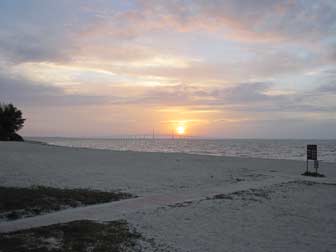
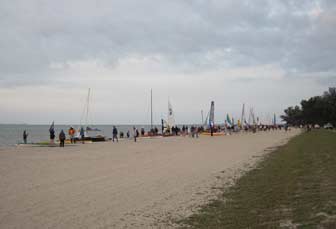
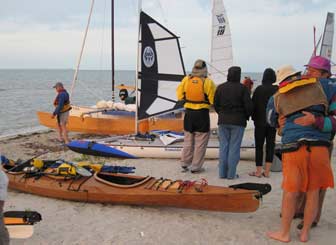
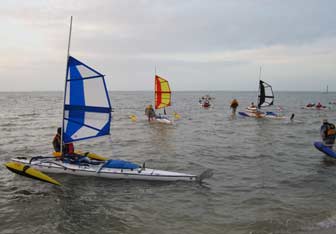
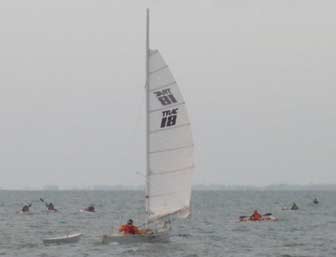
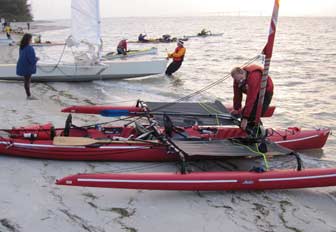
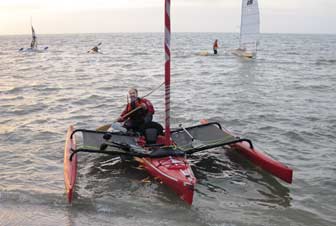
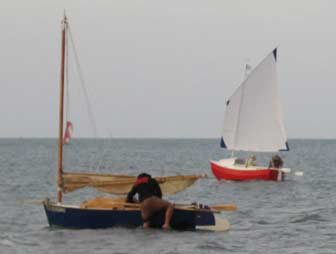
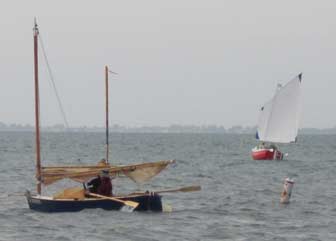
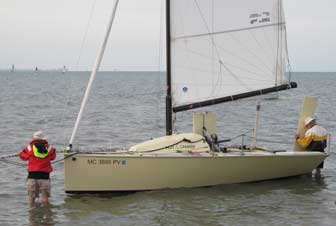
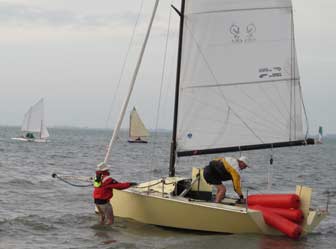
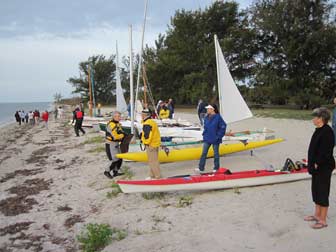
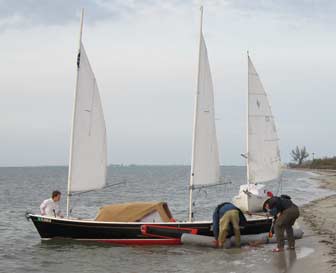
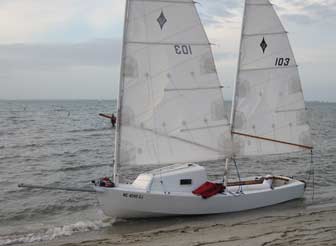
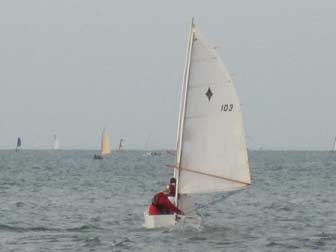
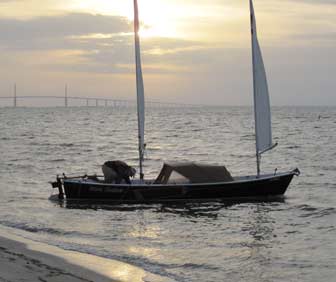
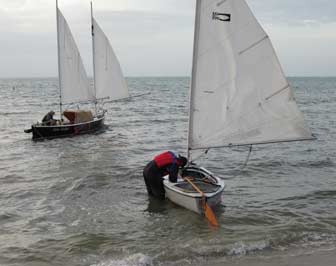
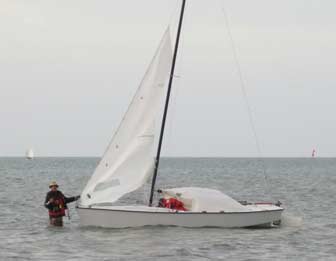
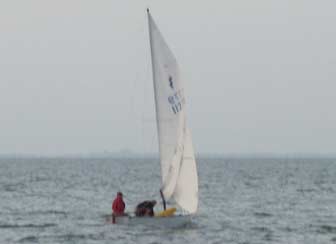
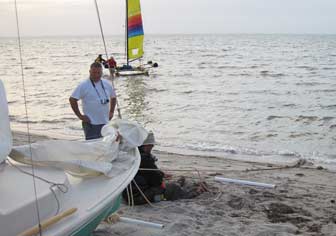
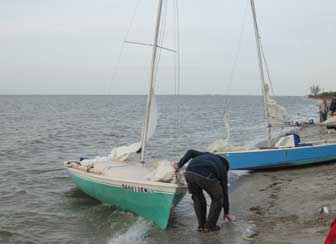
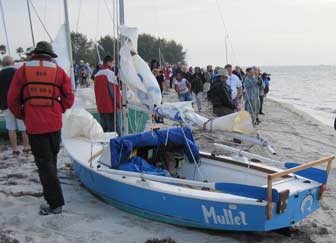
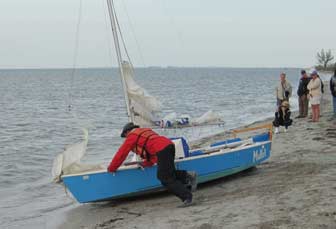
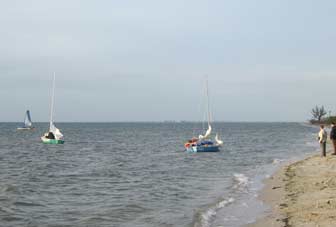
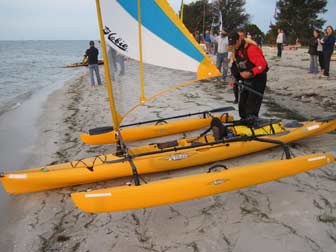
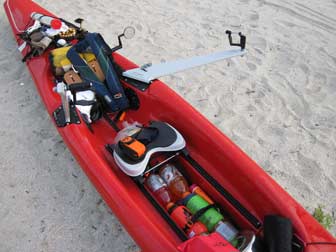
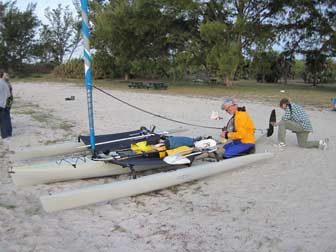
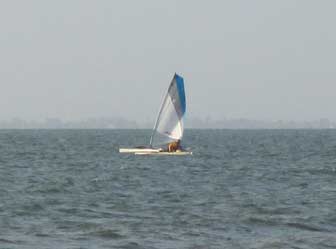
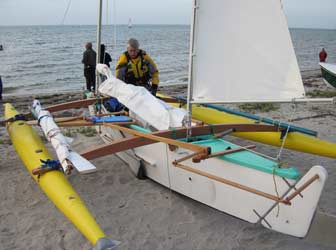
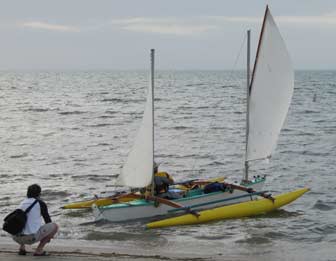
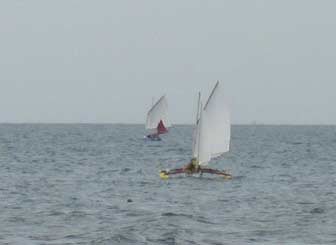
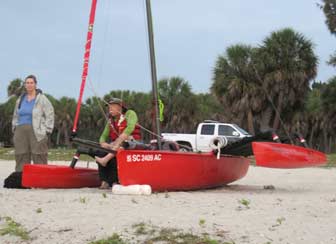
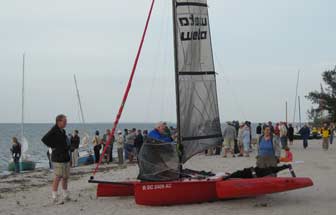
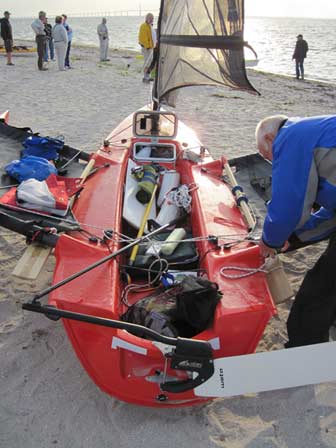
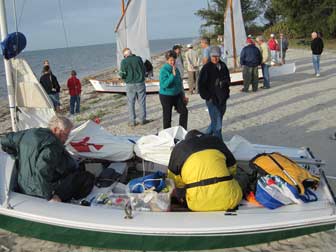
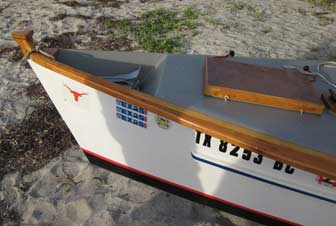
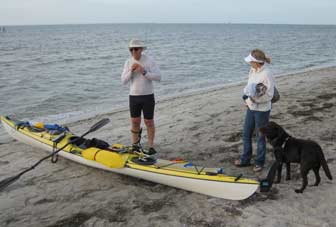
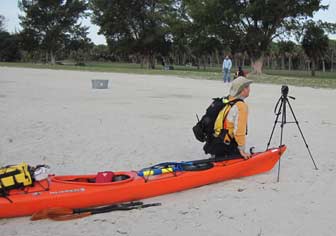
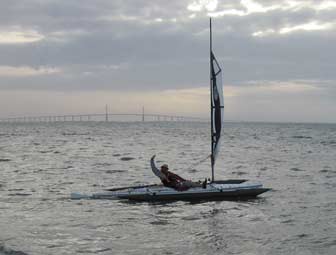
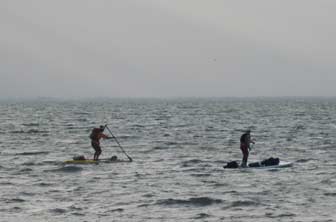
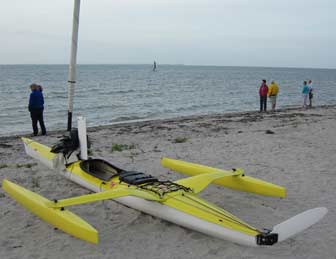
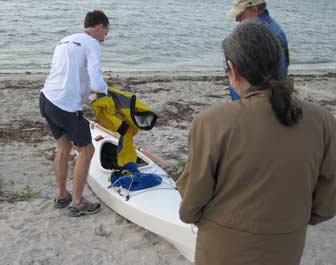
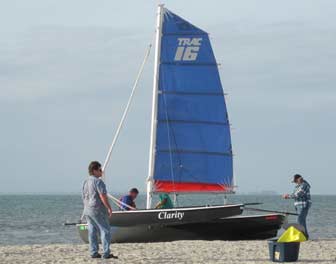
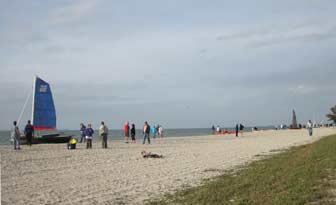
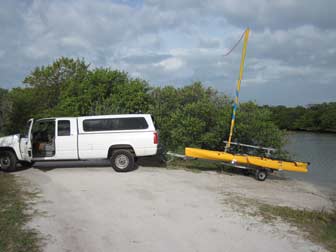
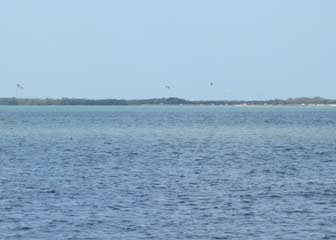
Leave a Reply
You must be logged in to post a comment.